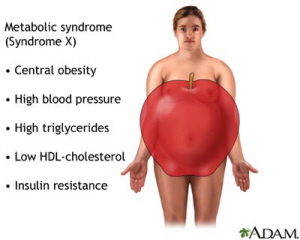A • B • C • D • E • F • G • H • I • J • K
L • M • N • O • P • Q • R • S • T
U • V • W • X • Y • Z
Medical Tests
Definitions
Macrovascular Disease: Disease of the large blood vessels, such as those found in the heart.
Lipids and blood clots build up in the large blood vessels and can cause atherosclerosis, coronary heart disease, stroke, and peripheral vascular disease.
Macula: The part of the retina in the eye used for reading and seeing fine detail.
Macular Edema: Swelling of the macula (part of the retina).
Maturity-Onset Diabetes of the Young (MODY): MODY is an autosomal dominant inherited disease that runs in families, usually occurs (onset) prior to age 25 and may or may not require insulin. It is different from type 1 and type 1 diabetes and may often be misdiagnosed.
Metabolic Syndrome: The tendency of several conditions to occur together, including obesity, insulin resistance, diabetes or pre-diabetes. hypertension. and high lipids.

Metabolism: The term for the way cells chemically change food so that it can be used to store or use energy and make the proteins, fats, and sugars needed by the body. Pre-diabetes, insulin resistance, type 2 and type 1 diabetes all affect carbohydrate metabolism by the body.
Mg/dL: Milligrams per deciliter, a unit of measure that shows the concentration of a substance in a specific amount of fluid. In the United States, blood glucose test results are reported as mg/dL. Medical journals and other countries use millimoles per liter (mmol/L). To convert to mg/dL from mmol/L, multiply mmol/L by 18.
Example: 10 mmol/L _ 18 = 180 mg/dL.
Microalbumin: Small amounts of the protein called albumin in the urine detectable with a special lab test.
Microaneurysm: A small swelling that forms on the side of tiny blood vessels. These small swellings may break and allow blood to leak into nearby tissue. People with diabetes may get microaneurysms in the retina of the eye.
Microvascular Disease: Disease of the smallest blood vessels, such as those found in the eyes, nerves, and kidneys. The walls of the vessels become abnormally thick but weak. Then they bleed, leak protein, and slow the flow of blood to the cells.
Mixed Dose: A combination of two types of insulin in one injection. Usually a rapid- or short-acting insulin is combined with a longer acting insulin (such as NPH insulin) to provide both short-term and long-term control of blood glucose levels.
Mmol/L (Millimoles per liter): A unit of measure that shows the concentration of a substance in a specific amount of fluid. In most of the world, except for the United States, blood glucose test results are reported as mmol/L. In the United States, milligrams per deciliter (mg/dL) is used. To convert to mmol/L from mg/dL, divide mg/dL by 18.
Example: 180 mg/dL ÷ 18 = 10 mmol/L.
MODY: See maturity-onset diabetes of the young (above.)
Monofilament Test: A short piece of nylon, like a hairbrush bristle, mounted on a wand is used to check sensitivity of the nerves in the foot. The doctor touches the filament to the bottom of the foot to see if the patient has lost feeling or sensitivity.
Mononeuropathy: Neuropathy (nerve damage) affecting a single nerve.
Myocardial Infarction: (heart attack). An interruption in the blood supply to the heart because of narrowed or blocked blood vessels.



